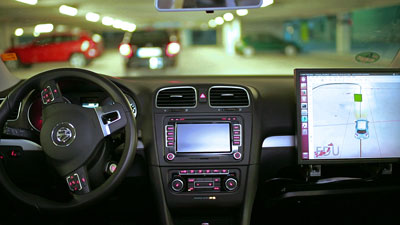| Aug 12, 2014 | |
My car drives, parks and charges itself for me |
|
| (Nanowerk News) Imagine you are rushing to catch a train but must first park your electric car inside the station garage. You lose precious time searching for a space, ideally one where you can charge your vehicle, which might cause you to miss the train. Wouldn’t it be nice if you could just drop off the car in front of the station and let it do the rest? Soon it will be possible, thanks to V-CHARGE, an EU ICT research project. Successful tests took place at Stuttgart airport in April 2014. | |
 |
|
| V-Charge | |
| In the future, more and more people are expected to drive electric cars due to energy consumption and environment reasons. As a result, people are also likely to switch more frequently from one transport mode to another – creating the need for better parking solutions at transport hubs. | |
| To prepare for this mobility shift, the V-CHARGE consortium – comprising six partners from four countries -- is working on a fully automated parking – and charging – system for electric cars at public car parks. Currently they have two electric test vehicles, one in Wolfsburg, and one in Zurich, and a third one is under development. | |
| 'The idea is that we can actually use technology to give people a better mix of public and private transport,’ says Dr. Paul Furgale , scientific project manager for V-CHARGE and deputy director of the autonomous systems lab at the Swiss Federal Institute of Technology in Zurich (ETH Zurich). ‘With a fully automated park and ride, drivers can get out of the car and immediately board the train without looking for parking. This will save each driver several minutes a day.' | |
| Another advantage of V-CHARGE is that it will lead to smoother traffic inside the garage, ensuring that empty spaces are filled quickly and keeping congestion to a minimum. | |
| Smartphones and sensors | |
| Using V-CHARGE, drivers will be able to exit the car in front of the car park and use a smartphone app to trigger the parking process. It works like this: The vehicle first connects with the car park’s server, which receives a drop-off signal from the phone; the server then figures out the route and communicates this to the car, which drives itself to the designated space. | |
| If another vehicle crosses its path, the electric car either stops to let it pass or maneuvers to avoid it. While in the garage, the car can also be programmed to drive itself to a charging station. Upon returning, the driver uses the same app to summon the car – fully charged and ready to drive. | |
| Since GPS satellite signals don’t work inside garages, the scientists have developed a camera-based system, which equips each car with a total of 8 cameras. | |
| The car needs to connect to the garage’s server and download a map which gives a description of the surroundings. By comparing the data collected by the cameras with data from the map, the vehicle can figure out exactly where it is and where it is going, and self-navigate to an appropriate spot. | |
|
The system will work in any garage, as long as cars are fitted with sensors and cameras similar to the ones already used today in parking assistance and emergency braking systems. Safety and accuracy With safety in mind, car speeds are limited to 10km an hour during the autonomous driving. After successfully demonstrating fully automated valet parking in the Bosch parking garage at Stuttgart airport, scientists are focusing now on improving the accuracy of parking maneuvers and in perfecting navigation. This way, the vehicles can deal reliably with any situation that arises, including changing lighting conditions or areas frequented by pedestrians. 'Parking areas can be extremely complex,' explains Dr. Furgale. 'The push in the last part of the project will be to really focus on dealing with dynamic environments and tracking dynamic objects on the scene.' |
|
| The project expects to demonstrate a proof-of-concept automated park & ride system by September 2015. | |
| The complete 'valet parking and charging' system is expected to be on the market in the next decade. Nevertheless, some of the components might be available much sooner. | |
| Eventually, Dr. Furgale believes the same technology could be used to develop autonomous parking systems for electric cars on city streets. 'That will be more of a challenge,' he says, 'but once you have the maps in place the rest of the technology will come together.' | |
| V-CHARGE is a 4 year project, funded with € 5.6 million by the European Union's SeventhFramework Programme (FP7). |
| Source: European Commission |
